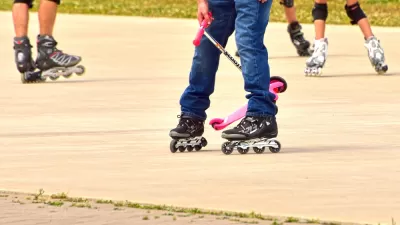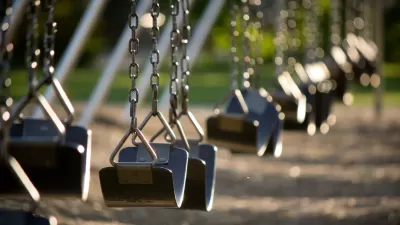Urban areas are filled with cars, and this creates an unsafe environment for children. This commentary argues that officials need to regain their faith in the power of planning to address the issue.
"Researchers at the University of the West of England have found that people who live in busy roads have fewer friends and acquaintances nearby, and feel worse about their neighbourhoods, than those in socio-economically similar but less traffic-filled streets. As John Vidal reported in last Friday's Guardian, the consequences could be far-reaching, given the links between neighbourliness and positive outcomes in many areas of people's lives."
"Traffic-filled streets are a double whammy for children. Road danger is a direct and lethal threat, and a realistic fear for parents, especially in the UK, which has a poor record on child pedestrian casualties compared to most other European countries. But car dependence also impoverishes children's lives, severing their links with the people and places around them."
"The point about traffic is that it is one area of public policy where the politicians have direct access to the key levers of change, through the planning system. Yet we have lost faith in the very idea that planning is a good way to tackle complex social problems. As a result, government policies are vague and wishy-washy at best, and local authorities don't have the political will to challenge the status quo. As a result, children are left exposed to the brutal market forces of individual adult choices."
FULL STORY: A world in a windscreen

Planetizen Federal Action Tracker
A weekly monitor of how Trump’s orders and actions are impacting planners and planning in America.

Maui's Vacation Rental Debate Turns Ugly
Verbal attacks, misinformation campaigns and fistfights plague a high-stakes debate to convert thousands of vacation rentals into long-term housing.

Restaurant Patios Were a Pandemic Win — Why Were They so Hard to Keep?
Social distancing requirements and changes in travel patterns prompted cities to pilot new uses for street and sidewalk space. Then it got complicated.

In California Battle of Housing vs. Environment, Housing Just Won
A new state law significantly limits the power of CEQA, an environmental review law that served as a powerful tool for blocking new development.

Boulder Eliminates Parking Minimums Citywide
Officials estimate the cost of building a single underground parking space at up to $100,000.

Orange County, Florida Adopts Largest US “Sprawl Repair” Code
The ‘Orange Code’ seeks to rectify decades of sprawl-inducing, car-oriented development.
Urban Design for Planners 1: Software Tools
This six-course series explores essential urban design concepts using open source software and equips planners with the tools they need to participate fully in the urban design process.
Planning for Universal Design
Learn the tools for implementing Universal Design in planning regulations.
Heyer Gruel & Associates PA
JM Goldson LLC
Custer County Colorado
City of Camden Redevelopment Agency
City of Astoria
Transportation Research & Education Center (TREC) at Portland State University
Jefferson Parish Government
Camden Redevelopment Agency
City of Claremont




























